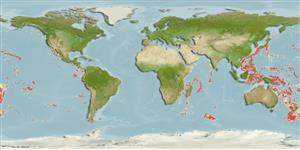Classification / Names
Common names from other countries
Main reference
Size / Weight / Age
Max length : 45.0 cm TL male/unsexed; (Ref. 4103)
Environment
Marine; benthopelagic; depth range 250 - 1185 m (Ref. 56809)
Climate / Range
Deep-water, preferred ?
Distribution
Short description
Dorsal
spines
(total): 0;
Dorsal
soft rays
(total): 87-94;
Anal
spines: 0;
Anal
soft rays: 69 - 75;
Vertebrae: 53 - 55. This species is characterized by the following set of characters: a relatively long lateral line ending below dorsal fin rays 19-26; dorsal fin rays 87-94, anal fin rays 69-75, precaudal vertebrae 15-16, total vertebrae 53-55 and total number of rakers on anterior gill arch 15-17 (3 long and 12-14 plates); longest gill raker 2.2-2.7% SL and snout to end of lateral line 48.0-56% SL; interorbital pore 1 and occipital pores 4 (Ref. 83453).
IUCN Red List Status (Ref. 115185)
Threat to humans
Harmless
Human uses
Fisheries: of no interest
More information
ReferencesAquacultureAquaculture profileStrainsGeneticsAllele frequenciesHeritabilityDiseasesProcessingMass conversion
Tools
Special reports
Download XML
Internet sources
Estimates of some properties based on models
Phylogenetic diversity index
PD50 = 0.5156 many relatives (e.g. carps) 0.5 - 2.0 few relatives (e.g. lungfishes)
Trophic Level
3.6 ±0.6 se; Based on size and trophs of closest relatives
Resilience
Medium, minimum population doubling time 1.4 - 4.4 years (Preliminary K or Fecundity.)
Vulnerability
Moderate vulnerability (39 of 100)
Price category
